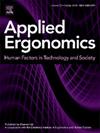Impact of ergonomic interventions on musculoskeletal health and work performance in dentists and dental students: a scoping review
IF 3.4
2区 工程技术
Q2 ENGINEERING, INDUSTRIAL
引用次数: 0
Abstract
Dentists face various occupational demands that heighten their risk of developing work-related musculoskeletal disorders (WMSDs), including prolonged static postures, repetitive movements, unsuitable dental instruments, extended work hours, and insufficient rest breaks. This scoping review (ScR) aims to systematically map the effects of ergonomics interventions on musculoskeletal and performance variables in dentistry. Following PRISMA Extension for Scoping Reviews (PRISMA-ScR), searches were conducted in the Medline/PubMed and Web of Science databases, covering studies published between 2012 and 2023. Out of 4362 articles initially retrieved, 51 met the eligibility criteria. These articles were analyzed qualitatively to assess the impact of physical, non-physical, and mixed ergonomic interventions. The most frequently studied intervention was the use of dental loupes, followed by physical exercise programs. Musculoskeletal variables included pain reduction, posture, muscle function, physical stress, and surface body temperature, while performance outcomes involved work efficiency, procedure duration, tool positioning, ease and quality of dental procedures, and concentration levels. Musculoskeletal variables were assessed in all 51 studies, with 10 also evaluating performance outcomes. Positive effects of ergonomic interventions were reported in 38 studies, while 13 showed inconclusive results. No negative effects were observed. Overall, ergonomic interventions offer potential benefits for improving both musculoskeletal health and work performance in dentists and dental students.
人体工程学干预对牙医和牙科学生肌肉骨骼健康和工作表现的影响:范围综述
牙医面临各种不同的职业需求,包括长时间的静态姿势、重复动作、不合适的牙科器械、工作时间延长和休息时间不足,这些都增加了他们患上与工作有关的肌肉骨骼疾病的风险。本范围综述(ScR)旨在系统地绘制人体工程学干预对牙科肌肉骨骼和性能变量的影响。根据PRISMA扩展范围评价(PRISMA- scr),在Medline/PubMed和Web of Science数据库中进行了搜索,涵盖了2012年至2023年间发表的研究。在最初检索的4362篇文章中,51篇符合资格标准。对这些文章进行定性分析,以评估物理、非物理和混合人体工程学干预措施的影响。研究中最常见的干预措施是使用牙镜,其次是体育锻炼计划。肌肉骨骼变量包括疼痛减轻、姿势、肌肉功能、身体压力和体表体温,而表现结果包括工作效率、手术持续时间、工具定位、牙科手术的易用性和质量以及注意力水平。所有51项研究都评估了肌肉骨骼变量,其中10项也评估了表现结果。38项研究报告了人体工程学干预的积极作用,而13项研究显示不确定的结果。没有观察到负面影响。总的来说,人体工程学干预为改善牙医和牙科学生的肌肉骨骼健康和工作表现提供了潜在的好处。
本文章由计算机程序翻译,如有差异,请以英文原文为准。
求助全文
约1分钟内获得全文
求助全文
来源期刊

Applied Ergonomics
工程技术-工程:工业
CiteScore
7.50
自引率
9.40%
发文量
248
审稿时长
53 days
期刊介绍:
Applied Ergonomics is aimed at ergonomists and all those interested in applying ergonomics/human factors in the design, planning and management of technical and social systems at work or leisure. Readership is truly international with subscribers in over 50 countries. Professionals for whom Applied Ergonomics is of interest include: ergonomists, designers, industrial engineers, health and safety specialists, systems engineers, design engineers, organizational psychologists, occupational health specialists and human-computer interaction specialists.
 求助内容:
求助内容: 应助结果提醒方式:
应助结果提醒方式:


